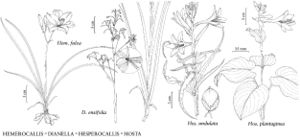Hemerocallis
Sp. Pl. 1: 324. 1753.
Gen. Pl. ed. 5, 151. 1754.
| Taxon | Illustrator ⠉ | |
|---|---|---|
 | Hemerocallis fulva Dianella ensifolia Hesperocallis undulata Hosta plantaginea | Yevonn Wilson-Ramsey Yevonn Wilson-Ramsey Yevonn Wilson-Ramsey Yevonn Wilson-Ramsey |
Herbs, perennial, scapose, clump-forming, rhizomatous, from fibrous or fleshy contractile roots often enlarged at ends; rhizomes spreading. Leaves many, basal, sessile, 2-ranked, bases sheathing; blade long-linear, keeled, apex acuminate. Inflorescences 2, in terminal helicoid-cyme, or solitary. Flowers mostly diurnal and ephemeral, slightly irregular, showy; tepals 6, connate basally into short, funnelform to campanulate tube, distinct parts imbricate, spreading, inner broader than outer; stamens 6, adnate to throat of perianth-tube; filaments curved upward, distinct, unequal; anthers dorsifixed, 2-locular, linear-oblong, dehiscence introrse; ovary superior, green, 3-locular, conic, septal nectaries present; style curved upwards; stigma indistinctly 3-lobed or capitate. Fruits capsular, leathery, dehiscence loculicidal. Seeds rarely produced (sterile) or many. x = 11.
Distribution
Introduced; temperate zones worldwide, temperate e Asia
Discussion
Species 15–30 (2 in the flora).
Hemerocallis is important economically as medicinal, poisonous, edible, and/or horticultural plants, which have been in Chinese culture for thousands of years (W. Erhardt 1992). Hemerocallin, a root neurotoxin, can be both poisonous and useful medicinally as an analgesic, diuretic, arsenic-poisoning antidote, and treatment for schistosomiasis (J. A. Duke and E. S. Ayensu 1985; W. Erhardt 1992; Hu S. Y. 1968). In Asia, flowers (buds and perianths), shoots, and tuberous roots (following suitable preparation) are important foods (G. Kunkel 1984). Daylilies are among the most popular North American garden plants. Registered cultivars of Hemerocallis now exceed 38,000, including more than 13,000 named clones of H. fulva (G. Grosvenor 1999; R. M. Kitchingman 1985; R. W. Munson Jr. 1989; W. B. Zomlefer 1998).
Hemerocallis has been included in a broadly circumscribed segregate family Hemerocallidaceae with 13–18 genera mainly from the Southern Hemisphere, especially Australia (W. B. Zomlefer 1998; H. T. Clifford et al. 1998), or placed alone in a monotypic Hemerocallidaceae (A. L. Takhtajan 1997).
The dwarf, yellow-flowered Hemerocallis minor P. Miller, grass-leaf daylily, has been reported as a local escape in Oregon.
Selected References
None.
Lower Taxa
Key
| 1 | Plants 7–15 dm; flowers not fragrant; tepals tawny orange, reticulate-veined; inner tepal margins wavy; capsules not or only rarely developing. | Hemerocallis fulva |
| 1 | Plants 5–10 dm; flowers fragrant; tepals lemon yellow, parallel-veined; inner tepal margins smooth; capsules fully developing. | Hemerocallis lilioasphodelus |
"broad" is not a number."thicker" is not a number.